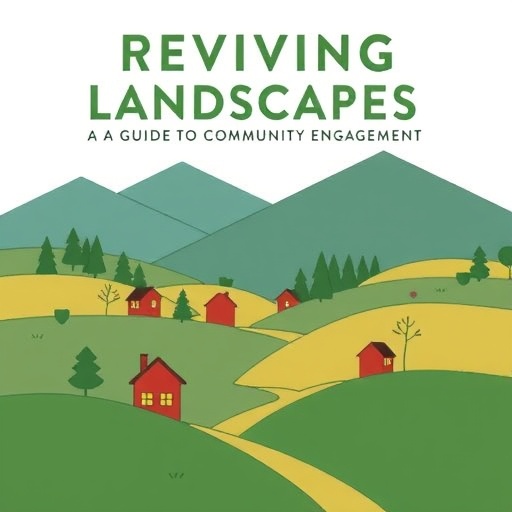Community-Led Landscape Regeneration: A Path Toward Environmental Transformation
In an era marked by unprecedented environmental challenges, the call for innovative approaches to ecosystem restoration has never been louder. Scholars and practitioners in the field of environmental science are increasingly advocating for community-led landscape regeneration as a viable and sustainable solution to restore degraded landscapes. Brown and Gabrys’s recent publication in Ambio presents not only a comprehensive review of various community engagement methods but also a robust framework for initiating and sustaining restorative initiatives that can empower local populations.
Community-led landscape regeneration stands as a beacon of hope in a world grappling with the consequences of climate change, biodiversity loss, and urbanization. The emphasis on local engagement highlights the crucial role communities play in the stewardship of their surroundings. This collaborative approach enables a deeper understanding of local ecosystems and environments, fostering a sense of responsibility and ownership among community members.
One of the key components of community-led regeneration is the recognition that local knowledge is invaluable. The Indigenous and traditional ecological knowledge held by local populations can inform restoration strategies that are more tailored to the specific needs of the landscape. Brown and Gabrys assert that respecting and integrating this indigenous knowledge into restoration efforts can significantly enhance the overall effectiveness of regeneration projects.
In their article, Brown and Gabrys explore the various strategies employed by successful community-led initiatives around the globe. These strategies include participatory decision-making processes, where community members have a voice in shaping the goals and methods of restoration projects. By prioritizing inclusivity, these initiatives foster a sense of unity and shared purpose that drives collective action toward common environmental objectives.
The researchers delve into the challenges faced by community-led landscape regeneration efforts. Among these hurdles are the potential lack of resources, the need for capacity building, and the complexities involved in navigating local governance structures. Importantly, Brown and Gabrys suggest that addressing these challenges requires a supportive framework that leverages local assets and fosters resilient community networks.
Moreover, the publication outlines best practices for fostering effective community engagement. Successful projects often include educational components aimed at raising awareness about environmental issues and the importance of restoration efforts. By equipping community members with the knowledge and skills necessary to actively participate in regeneration initiatives, these programs enable individuals to transform from passive observers into active agents of change.
Collaboration with local governments and stakeholders is another critical aspect highlighted by Brown and Gabrys. Establishing alliances with public institutions enhances resource mobilization and helps align community objectives with broader environmental policies. Such partnerships can mitigate conflicts and promote a harmonious approach to landscape regeneration.
The role of technology in community-led initiatives is also examined in their review. Advancements in digital tools and platforms facilitate communication and coordination among community members, as well as provide valuable data for monitoring restorative efforts. From Geographic Information Systems (GIS) used to map biodiversity to social media campaigns aimed at mobilizing support, technology serves as a powerful ally in the pursuit of effective landscape regeneration.
Furthermore, the researchers emphasize the significance of adaptive management in community-led initiatives. As restoration projects unfold, continuous learning and adjustment allow communities to refine their methods and improve outcomes. This iterative process is essential to respond to changing environmental conditions, ensuring that regeneration efforts remain viable and impactful over time.
Brown and Gabrys also explore case studies from various regions, showcasing the diverse contexts within which community-driven landscape regeneration can flourish. These case studies highlight the unique ecological, cultural, and economic factors that shape each community’s approach to restoration, underscoring the notion that there is no one-size-fits-all model. Instead, successful initiatives arise from a deep understanding of local contexts combined with globally inspired frameworks.
In reflecting on the future of community-led landscape regeneration, the authors advocate for increased investment in grassroots initiatives. Such investments not only support ecological restoration but also contribute to social cohesion, resilience, and community well-being. By acknowledging the multifaceted benefits of engaging communities in restorative efforts, policymakers can help foster environments where both nature and people thrive.
The implications of community-led landscape regeneration extend beyond mere environmental restoration. Engaging communities in these initiatives cultivates a sense of belonging and pride in one’s environment. As participants witness the tangible outcomes of their efforts – flourishing ecosystems and revitalized landscapes – they become champions for sustainability, inspiring others to take action for the planet.
In conclusion, Brown and Gabrys’s work offers a compelling vision for the future of ecosystem restoration. By prioritizing community engagement, integrating local knowledge, and leveraging partnerships, society can embark on a transformative journey toward healing the environment. As evidence mounts on the effectiveness of these collective efforts, it becomes clear that community-led landscape regeneration is not just a necessary response to ecological degradation; it is a powerful catalyst for cultural and social revitalization as well.
By harnessing the passion and creativity of local communities, we pave the way for a more sustainable and harmonious coexistence with our natural world. The challenges ahead are daunting, but with innovative, community-driven approaches, we can rekindle the hope for a greener, healthier planet.
Subject of Research: Community-led Landscape Regeneration
Article Title: Community-led landscape regeneration: A review of and framework for engagement in restoration initiatives.
Article References:
Brown, D., Gabrys, J. Community-led landscape regeneration: A review of and framework for engagement in restoration initiatives.
Ambio (2025). https://doi.org/10.1007/s13280-025-02236-3
Image Credits: AI Generated
DOI: 20 September 2025
Keywords: Community engagement, landscape regeneration, environmental restoration, ecological knowledge, participatory decision-making, adaptive management, grassroots initiatives.




